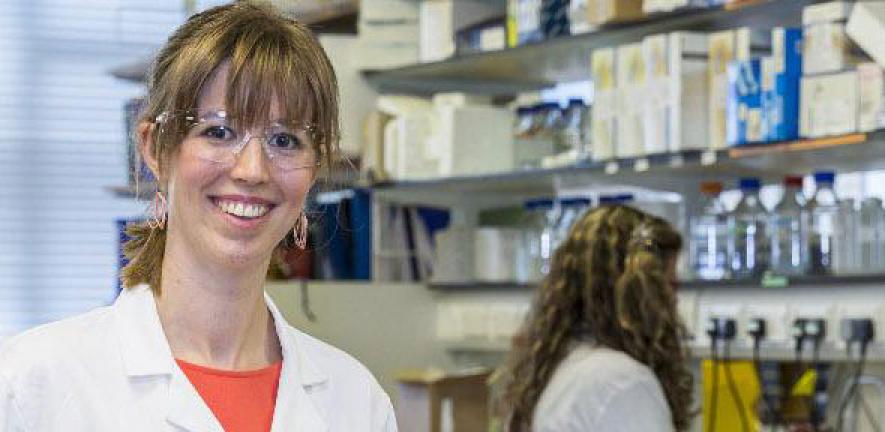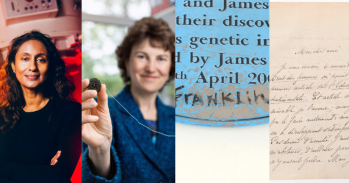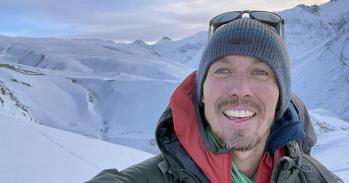
“I was taught that the way of progress is neither swift nor easy”.
“I was taught that the way of progress is neither swift nor easy”.
I think it’s absolutely vital, at every opportunity, for all of us to honour and promote girls and women in science.
Anna-Maria Pappa
It’s unlikely, as she wrote these words, that Dr Marie Sklodowska-Curie ever imagined the ongoing pathways of progress she had catalysed. Today, the United Nations’ International Day of Women and Girls in Science, the pioneer who paved the way for generations of women to pursue careers in science, technology, engineering, mathematics and medicine (STEMM) is one of the many successful women whose work is being celebrated around the world.
The first person in history to receive two Nobel Prizes (her first was in physics; followed by the award for chemistry) remains an inspiration to scientists of all disciplines. Among them is Dr Karen Stroobants, a postdoctoral researcher in the Centre for Protein Misfolding Diseases, based in Cambridge’s Department of Chemistry. Her research focuses on the proteins associated with Alzheimer’s, Parkinson’s and other neurodegenerative diseases.
She said: “The day I learned about Marie Curie, I came home and told my mother I was going to become a chemist … I have been intrigued by her life path and accomplishments from the first time I heard about her, and she remains my most important role model.”
Yet more than a century after Sklodowska-Curie became the first woman to win a Nobel Prize, her words hold particular significance when viewed through a different lens. The UN’s global event was established in response to the gender divide in the scientific community, in a bid to help address the continuing disparity that exists across the board.
In the United Kingdom women currently account for 24% of those working in the core STEM industries such as construction, information and communication technology and manufacturing. Women make up just 11% of the total number of professional engineers, and 42% of science professionals such as geologists, physicists and biochemists.
In his message about the event, the UN’s Secretary General António Guterres, himself a trained engineer and former maths teacher, said: “Both girls and boys have the potential to pursue their ambitions in science and mathematics, in school and at work. But systemic discrimination means women occupy less than 30 per cent of research and development jobs worldwide. We need concerted, concrete efforts to overcome stereotypes and biases. One starting point is banishing the predominantly male images of scientists and innovators on social media, in textbooks and in advertising.”
“We need to encourage and support girls and women to achieve their full potential as scientific researchers and innovators. Women and girls need this, and the world needs this, if we are to achieve our ambitions for sustainable development on a healthy planet. Throughout history, from Hildegard of Bingen to Wangari Maathai, women scientists have built our world. It’s time to support and invest in them.”
Stroobants agrees that more needs to be done before gender equality is achieved.
She said: “There is a need for initiatives not only to stimulate young girls to take up STEMM directions, but as importantly, also to stimulate young female professionals to take up leadership roles. Putting these issues in the spotlight is very important as it increases awareness, which is the first requisite for positive action.”
“Although programmes have been set up within institutions and universities to address the gender imbalance in academia specifically, I believe more general societal changes will have a larger impact.”
“Changes that contribute to a more gender balanced society will result in an increased number of female scientists. The girl-boy mentality gets fed to our children from a very early age, with gender-specific toys, activities and behaviour. I believe there are huge opportunities for behavioural scientists to address many of these issues.”
Stroobants also believes that teachers play a key role in helping to motivate and inspire younger students to study STEMM subjects.
“Good teachers, that share their interest in the world around them and are accessible for all children, are of vital importance to motivate youngsters to take up studies in the sciences. Female teachers, as role models, can further stimulate girls in particular to see the feasibility of pursuing a STEMM career.”
The drive to motivate girls to study science is shared by many at the University. Dr Anna-Maria Pappa, from the Department of Chemical Engineering and Biotechnology, was recently awarded a L'Oréal-UNESCO for Women in Science Fellowship, and has spoken of her commitment to encouraging young girls to study STEMM subjects.
She said: “I think it’s absolutely vital, at every opportunity, for all of us to honour and promote girls and women in science. Each one of us should in every way that we can inspire girls to pursue an education in science, as well as support women’s right to equal opportunities in every sector of professional life.”
Cambridge has been home to a wealth of noteworthy female scientists. Among them is the chemist Rosalind Franklin, who played a vital early role in the discovery of the structure of DNA. The notebook she used to record her original findings is now held at the Churchill Archives Centre. Other female scientists whose papers are now held at the archives include Dame Enid Russell Smith, who played an instrumental role in setting up the National Health Service, the physicist Lise Meitner, and Mavis Beaty, a codebreaker who worked at Bletchley Park during the Second World War. The documents include notebooks, working papers, lecture notes and personal correspondence.
Natalie Adams in a Senior Archivist at the College. She said: “The wonderful thing about archives is that they give the sense of the person as a whole, they don’t just focus on one element.”
“The growing collection of documents created by women in science is a great asset to the archives. It’s interesting that often the papers by female scientists are more popular than those written by their male counterparts.”
“I think it’s often the case that people recognise that many of these women didn’t receive the recognition they deserved during their lifetime, and people today are interested in the reasons behind this and learning more about the culture in which these women worked.”
Beyond the University, other projects and initiatives are in place to help women build successful careers in science. The Cambridge Association for Women in Science and Engineering (CamAWiSE) is a regional network that provides opportunities for women in STEMM to meet and provide peer support and guidance. They also help women who want to return to work following a career break.
“We have a deficit of engineers and scientists in the UK, and at the same time we are losing women scientists every year,” said Aldara Dios, the orgnaisation’s coordinator. “Not only do fewer women follow STEMM careers than men but they also abandon their professions more. We are not only losing numbers, but also diversity.”
“Glass ceilings, unconscious bias, gender wage gap, work-life balance, lack of role models, and not inclusive workplaces are some of the challenges women in STEMM face.”
“The UN's International Day of Women and Girls in Science is a powerful initiative. It helps visualise these problems and forces conversation on the topic at least one day a year.”
Cathy Sorbara is the current co-chair of the association. She holds a PhD in Medical Life Science and Technology, and is the Chief Operating Officer of Cheeky Scientist, a global organisation that works to help PhD graduates transition into industry.
The work that CamAWiSE does to provide a network of support is something that Cathy feels is an important element in helping women to succeed. She said: “I think there is a desperate need for mentorship and support for women to stop them falling through the leaky pipeline, both in academia and in industry.”
Sorbara is committed to making changes to the scientific community, and on Tuesday will embark on the 2018 Homeward Bound expedition to Antarctica. This is the culmination of a year-long course to provide female scientists with the skills they need to be leaders in their field. The initiative aims to build a network of women over the next ten years who will go on to occupy leadership roles in STEMM disciplines.
Referring to the UN event, Sorbara says anything that raises awareness of female scientists is a positive thing.
She said: ‘I think we’ve come quite far, but we have quite a way to go. When I talk about this topic I’m always reminded of the quote ‘If you want to go fast go alone; if you want to go far go together’. This event is a positive thing because it will bring attention to the topic, but it’s also up to schools and companies to do all they can to leverage this and do more to help address the gender divide.”
Her words have echoes of Dr Sklodowska-Curie’s observation on the way of progress. The road to gender equality in the scientific community is proving to be neither swift nor easy, and today’s global event is not only an acknowledgement of the accomplishments and successes of so many female scientists, but also a reminder of the changes needed for progress towards gender equality be continue.

The text in this work is licensed under a Creative Commons Attribution 4.0 International License. For image use please see separate credits above.




